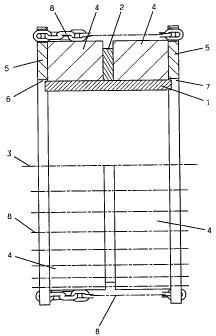Une partie des informations de ce site Web a été fournie par des sources externes. Le gouvernement du Canada n'assume aucune responsabilité concernant la précision, l'actualité ou la fiabilité des informations fournies par les sources externes. Les utilisateurs qui désirent employer cette information devraient consulter directement la source des informations. Le contenu fourni par les sources externes n'est pas assujetti aux exigences sur les langues officielles, la protection des renseignements personnels et l'accessibilité.
L'apparition de différences dans le texte et l'image des Revendications et de l'Abrégé dépend du moment auquel le document est publié. Les textes des Revendications et de l'Abrégé sont affichés :
| (12) Brevet: | (11) CA 2394601 |
|---|---|
| (54) Titre français: | ROULEAU D'ENTRAINEMENT ET PROCEDE D'ASSEMBLAGE D'UN ROULEAU D'ENTRAINEMENT |
| (54) Titre anglais: | FEED ROLLER AND A METHOD FOR ASSEMBLING A FEED ROLLER |
| Statut: | Périmé |
| (51) Classification internationale des brevets (CIB): |
|
|---|---|
| (72) Inventeurs : |
|
| (73) Titulaires : |
|
| (71) Demandeurs : |
|
| (74) Agent: | SMART & BIGGAR IP AGENCY CO. |
| (74) Co-agent: | |
| (45) Délivré: | 2008-07-08 |
| (86) Date de dépôt PCT: | 2000-12-08 |
| (87) Mise à la disponibilité du public: | 2001-07-05 |
| Requête d'examen: | 2003-11-06 |
| Licence disponible: | S.O. |
| (25) Langue des documents déposés: | Anglais |
| Traité de coopération en matière de brevets (PCT): | Oui |
|---|---|
| (86) Numéro de la demande PCT: | PCT/SE2000/002471 |
| (87) Numéro de publication internationale PCT: | WO2001/047672 |
| (85) Entrée nationale: | 2002-06-17 |
| (30) Données de priorité de la demande: | ||||||
|---|---|---|---|---|---|---|
|
L'invention se rapporte à un rouleau d'entraînement mis en oeuvre dans une machine de traitement du bois et conçu pour amener des troncs d'arbres dans ladite machine. Ce rouleau d'entraînement se caractérise en ce qu'il comporte une bride (2) disposée sensiblement au centre de la jante (1) de roue et en ce qu'un tracé (4) de matière élastique est disposé de part et d'autre de la bride (2). Un anneau (5) est disposé sur le côté du tracé respectif (4) qui est opposé à la bride, ce qui permet aux anneaux (5) qui sont en aboutement avec les côtés externes du tracé élastique de part et d'autre de la roue de s'assembler au moyen de dispositifs de mise en tension (8).
Feed roller in tree processing machinery for feeding
tree trunks through the machinery distinguished in that the
flange (2) is arranged essentially in the centre of the wheel rim
(1) and that a track (4) of elastic material is arranged on either
side of the flange (2). A ring (5) is arranged on the side of the
respective track (4) that is opposite the flange, whereby the rings
(5) that abut the outer sides of the elastic track on either side of the
wheel are joined with one another by means of tensioning devices
(8).
Note : Les revendications sont présentées dans la langue officielle dans laquelle elles ont été soumises.
Note : Les descriptions sont présentées dans la langue officielle dans laquelle elles ont été soumises.

Pour une meilleure compréhension de l'état de la demande ou brevet qui figure sur cette page, la rubrique Mise en garde , et les descriptions de Brevet , États administratifs , Taxes périodiques et Historique des paiements devraient être consultées.
| Titre | Date |
|---|---|
| Date de délivrance prévu | 2008-07-08 |
| (86) Date de dépôt PCT | 2000-12-08 |
| (87) Date de publication PCT | 2001-07-05 |
| (85) Entrée nationale | 2002-06-17 |
| Requête d'examen | 2003-11-06 |
| (45) Délivré | 2008-07-08 |
| Expiré | 2020-12-08 |
Il n'y a pas d'historique d'abandonnement
Les titulaires actuels et antérieures au dossier sont affichés en ordre alphabétique.
| Titulaires actuels au dossier |
|---|
| PARTEK FOREST AB |
| Titulaires antérieures au dossier |
|---|
| NILSSON, GUNNAR |